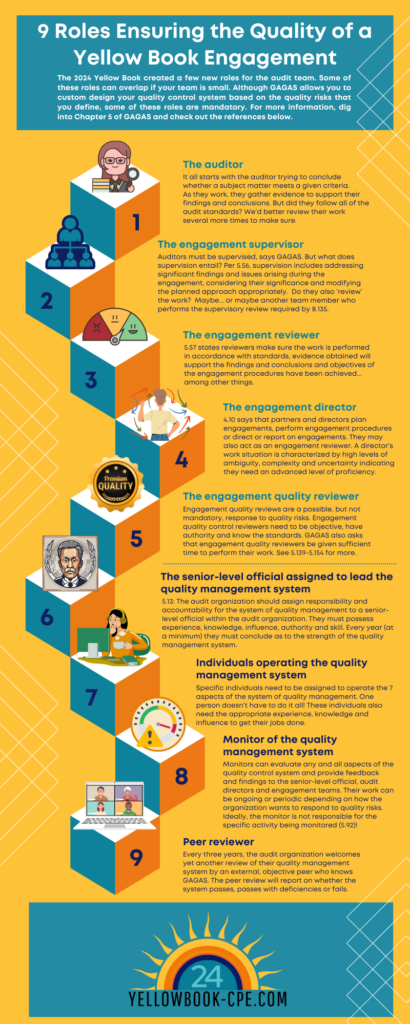The 2024 Yellow Book created a few new roles for the audit team. Some of these roles can overlap if your team is small. Although GAGAS allows you to custom design your quality control system based on the quality risks that you define, some of these roles are mandatory. For more information, dig into Chapter 5 of GAGAS and check out the references below.
9 roles ensuring quality
1. The auditor
It all starts with the auditor trying to conclude whether a subject matter meets a given criteria. As they work, they gather evidence to support their findings and conclusions. But did they follow all of the audit standards? We’d better review their work several more times to make sure.
2. The engagement supervisor
Auditors must be supervised, says GAGAS. But what does supervision entail? Per 5.56, supervision includes addressing significant findings and issues arising during the engagement, considering their significance and modifying the planned approach appropriately. Do they also ‘review’ the work? Maybe… or maybe another team member who performs the supervisory review required by 8.135.
3. The engagement reviewer
5.57 states reviewers make sure the work is performed in accordance with standards, evidence obtained will support the findings and conclusions and objectives of the engagement procedures have been achieved… among other things.
4. The engagement director
4.10 says that partners and directors plan engagements, perform engagement procedures or direct or report on engagements. They may also act as an engagement reviewer. A director’s work situation is characterized by high levels of ambiguity, complexity and uncertainty indicating they need an advanced level of proficiency.
5. The engagement quality reviewer
Engagement quality reviews are a possible, but not mandatory, response to quality risks. Engagement quality control reviewers need to be objective, have authority and know the standards. GAGAS also asks that engagement quality reviewers be given sufficient time to perform their work. See 5.139-5.154 for more.
6. The senior-level official assigned to lead the quality management system
5.13: The audit organization should assign responsibility and accountability for the system of quality management to a senior-level official within the audit organization. They must possess experience, knowledge, influence, authority and skill. Every year (at a minimum) they must conclude as to the strength of the quality management system.
7. Individuals operating the quality management system
Specific individuals need to be assigned to operate the 7 aspects of the system of quality management. One person doesn’t have to do it all! These individuals also need the appropriate experience, knowledge and influence to get their jobs done.
8. Monitor of the quality management system
Monitors can evaluate any and all aspects of the quality control system and provide feedback and findings to the senior-level official, audit directors and engagement teams. Their work can be ongoing or periodic depending on how the organization wants to respond to quality risks. Ideally, the monitor is not responsible for the specific activity being monitored (5.92)!
9. Peer reviewer
Every three years, the audit organization welcomes yet another review of their quality management system by an external, objective peer who knows GAGAS. The peer review will report on whether the system passes, passes with deficiencies or fails.
Want to learn more?
Want to dig into the new changes and find out more about these 9 roles ensuring quality with a certifiable Yellow Book nerd? Then join Leita on June 25 for the two-hour webinar GAGAS 2024: The New Quality Management System. She will guide you through what you need to know to pass that next peer review. As a bonus, receive Leita’s Excel spreadsheet that walks you through a GAGAS compliant quality management system including risk assessment.


 Yellowbook-CPE.com is registered with the National Association of State Boards of Accountancy (NASBA) as a sponsor of continuing professional education on the National Registry of CPE Sponsors. State boards of accountancy have final authority on the acceptance of individual courses for CPE credit. Complaints regarding registered sponsors may be submitted to the National Registry of CPE Sponsors through its website:
Yellowbook-CPE.com is registered with the National Association of State Boards of Accountancy (NASBA) as a sponsor of continuing professional education on the National Registry of CPE Sponsors. State boards of accountancy have final authority on the acceptance of individual courses for CPE credit. Complaints regarding registered sponsors may be submitted to the National Registry of CPE Sponsors through its website: